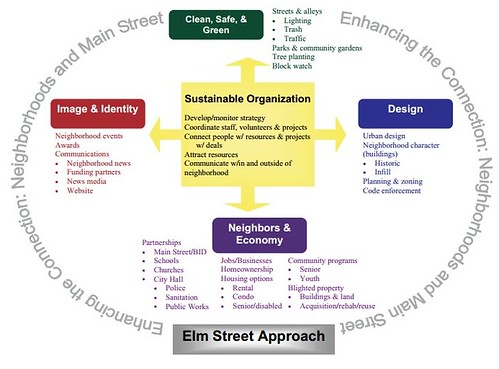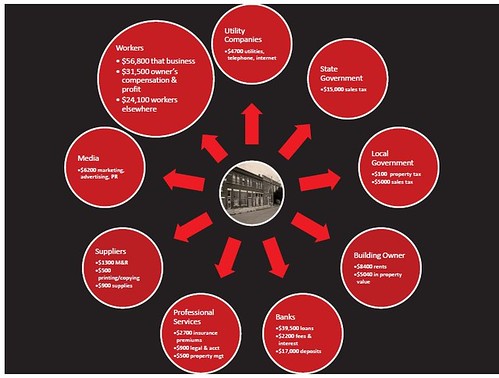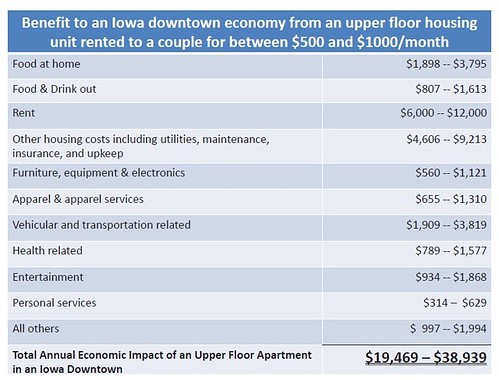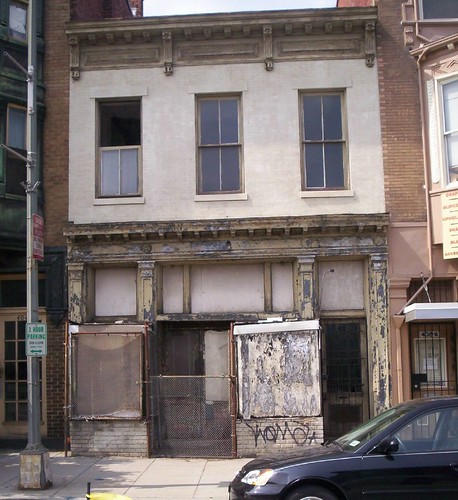Historic preservation economic benefits
The reason that people like economist Ed Glaeser and writer Matt Yglesias rail against historic preservation is because in strong real estate markets like the central business district in Downtown DC or in many neighborhoods in Manhattan, Brooklyn, and Queens in New York City, historic preservation protections generally prevent land use intensification--replacement of small buildings with typically much larger ones, or the replacement of residential building stock with commercial buildings.
Residents of those communities would counter that their houses, commercial buildings and neighborhoods that are designated as historic contribute to the quality of life, diversity, and economic success of their respective cities.
The reality is that there are but a handful of areas across the US where this is an issue. Mostly, neighborhoods and commercial districts are desperate for investment, and demand for intensification is non-existent.
In weaker real estate markets (which included much of Washington, DC up til about 2003), historic preservation designation is a revitalization tool which helps to reposition and stabilize neighborhoods and commercial districts and town centers when ordinarily, real estate trends in the metropolitan area normally passes these places by.
Recently, a couple of reports have been released that discuss the economic value of historic preservation in what I would call weaker real estate markets. (There are many such reports on this topic, so many that I wonder why we still find it necessary to produce them, except for the fact that elected officials and many other stakeholders appear to remain unconvinced.)
Pennsylvania
The report, Economic Benefits of Historic Preservation Activities in Pennsylvania produced for the Bureau of Historic Preservation of the State of Pennsylvania, details the economic benefits of heritage tourism, stabilization and property value increases in historically designated neighborhoods, and the economic value of commercial district revitalization.
Interestingly, Preservation Pennsylvania, the statewide preservation advocacy group, produced a complementary report, Policy Recommendations to Strengthen the Power of Preservation, outlying their recommendations for policy and program changes, to further the economic benefits of preservation, including continued support of existing programs, the creation of a state tax credit program (which was done in 2012), and better coordination of tourism promotion programs.
 Pennsylvania also has a neighborhood/residential revitalization program based on the Main Street commercial district revitalization program model, but modified to be fully focused on residential improvement, called Elm Street.
Pennsylvania also has a neighborhood/residential revitalization program based on the Main Street commercial district revitalization program model, but modified to be fully focused on residential improvement, called Elm Street.Iowa
The Main Street Iowa program commissioned a study of the economic impact of the state program, now operating in almost 40 communities, over the 26 year existence of the program. See "Main Street Iowa coming back to life: Small towns restore historic downtowns with program's aid" from the Des Moines Register (which also has a link to the report summary but the full study doesn't seem to be online). From the article:
Main Street Iowa already had tallied a cumulative 11,000 net new jobs created, 3,800 net new businesses and nearly $1.2 billion in private investment in its downtown districts. ...
• $71.93 has been invested back into Main Street communities for every dollar it takes to run the program. (In recent years that ratio has soared as high as $130 for every dollar.)
• $43 million in sales tax from net new businesses has been collected annually.
• The increased assessed value of Main Street properties has provided the state $10.8 million over the life of the program “to pay cops and fix potholes.”
• Main Street communities have enjoyed net job growth in 25 out of 26 years. Iowa overall, meanwhile, suffered net job loss in seven years.
The various economic studies over the years of the economic return from various historic preservation activities, commercial district revitalization, cultural heritage tourism promotion and programming, neighborhood revitalization, and building rehabilitation demonstrate an extremely high rate of return, from $5 to $100+ back for every dollar invested.
I liked a couple of the slides from the Iowa presentation because they show two important things. One was a good illustration of what is called the economic multiplier effect of commercial district revitalization and from the money that businesses spend on services--and how it makes such a difference to spend "local."
Economic multiplier benefit of investment in commercial district revitalization

Economic value of the addition of housing to neighborhoods and commercial districts

While the slide is focused on adding housing to commercial districts, the reality is that this slide communicates a broader truth, about how the addition of new households to communities--not just "downtown"--contributes to the economic health of the neighborhood and city more broadly.
This is in fact what is happening with the population influx that DC is experiencing now.
New residents spend money, and more residents spend more money than fewer residents and some of it (more if there are more places to spend it that are local) is spent locally.
New spending allows for the revitalization of neighborhood commercial districts, places like 11th Street NW in Columbia Heights or Barracks Row on 8th Street SE in Capitol Hill or Upshur Street and Georgia Avenue in the area served by the Petworth Metro Station (which has been stoked by the addition of multiunit housing to the area), or 14th Street between Thomas Circle and U Street (in response to the Whole Foods Supermarket and the addition of a goodly amount of multiunit housing), etc.
And it is just in the last couple of years where these changes have become truly visible, having reached a kind of "critical mass" or "tipping point," coincident with escalation in the number of people moving into the city (about 1,000 people per month over the last two years).
DC doesn't offer a "state historic tax credit": and that's just fine
So the director of the DC Preservation League has a piece, "D.C. lags in incentives for historic preservation: Virginia and Maryland provide tax breaks missing in the District to rehab commercial properties," in the Washington Business Journal lamenting that DC lacks a local tax credit to spur historic rehabilitation. One of the two benefits of federal designation is the eligibility for the use of a tax credit for up to 20% of the cost of rehabilitating the property to historic standards.
Often this tax credit is used in association with other tax credit programs, such as the New Markets Tax Credit, or state tax credits--many states offer such, including Maryland and Virginia--and economic value imputed from easements.
The reason that many projects use these variety of tax credits is that in weak real estate markets, you need additional sources of capital in order to make the project work financially. Plus the projects usually have to be big, in order to be worthwhile to go through the project costs associated with getting the credits. I don't know the exact rule of thumb, but it's probably at least $5 million to $10 million.
That's why tax credit projects are big in cities like Baltimore, Cleveland, Milwaukee, St. Louis, Pittsburgh, and Philadelphia, among other places. They have many big buildings, that are tough to redevelop--so-called "white elephants"--and they are weaker markets. That's the right combination that justifies tax credit usage.
DC isn't a weak real estate market and for the most part, doesn't have the large buildings and old manufacturing plants that can be hundreds of acres in size possessed by the other cities.
Do we really need to give up property tax revenues to properties that are going to be rehabilitated anyway?
Currently, there is a method (too ad hoc for me, but...) where DC property owners can request tax abatement to assist them in the redevelopment of problem properties, I think that works just fine for those cases where extraordinary circumstances justify such assistance.
But giving away money to properties that will be rehabilitated anyway should be off the table.
 One local DC historic preservation tax credit program that would make sense
One local DC historic preservation tax credit program that would make senseThe federal tax credit program, and probably most state programs, make the most sense for large buildings and projects, where the value is many millions.
But someone owning a small building isn't placed to be able to participate in that program, even if the cost to rehabilitate a property that has mouldered for many years can be many hundreds of thousands of dollars.
Creating a "small projects" state historic tax credit program, to assist this kind of rehabilitation, is definitely in order.
The building at right has been vacant for every day of the 25+ years that I have lived in DC. (It's since been boarded up better and painted a bit since this picture was taken.) Likely it will need a lot of money to be able to be used, more than would normally be able to recouped back in normal rents. Although given that a supermarket is opening on the next block later this year will change the economics for this particular building. Still, leaving a building empty for upwards of 30 years doesn't help the commercial district, the neighborhood, or the city.
A targeted tax break for commercial properties like these makes much more sense than an untargeted tax credit program that would assist large property owners who don't realy need the inducements.
Labels: building a local economy, commercial district revitalization, economic development, economic impact studies, historic preservation, real estate development, urban design/placemaking, urban revitalization



7 Comments:
I think what the "urban economists" -- and I use that term loosely -- miss is the market isn't driven by equlimbrum, it is driven by greed. The market works as a price signal because it indicates where money is going to be made. That sometimes leads to highly undesirable outcomes.
That being said, the contra is true as well -- a large majority of "historical' neighboorhoods aren't worth saving using the tools of historical preservation. I'd agree with you that many of them are built with a lost art and design, but even with pedestrian friendly features they aren't useful in modern times.
But actually I agree with your final point that isn't about abstract historical preservation and developing small / individual properties. And the market might be doing that by denying funding to large scale developers right now.
I'd do a audit every year, and say, ok, these are the 10 worse properities in the area and are hurting the development of everyone else. Do the rights on those until the area starts to take off. In reality, like crime, it is a very small minority that are causing the problems and the future beenfit of tax revenue will offset it.
eminent domain... (e.g., some of the properties that Douglas Development sits on for decades...)
doesn't the vacant property tax capture a bit of that?
or go back to an earlier idea I tossed out of ranking developers and favoring ones that make the long term investment -- and freeze out Douglas Jemal.
HP clearly has become a corrup process on Capitol Hill with the "restoration society" . They are all about NIMBY issues and allow endangered buildings to languish or to outright fall down. There needs to be a new HP outfit- one that that actually seeks to protect buildings and not to be used as a vehicle against new construction, to promote parking and to fight density, cycling stations, transit [ CHRS is against the new streetcars] and also is comprised of ELECTED people and not just senior citizens with a warped perspective on urbanism. CHRS is out of line and out of date. They hate the yonug people moving into the area and they need to leave the city. All of the focus on fighting the new Himes project has already resulted in one residential structure being demolished [ C street s.e.] and Friendship House is now in danger from the neglect of CHRS when they should have been paying attention. They go after individual home and property owners in retribution and their mission has been perverted and debased. A new society should be formed dedicated ONLY to HP.
I have talked with a few real estate finance people about the DC credit issue. The fact that the Historic Preservation Tax Credit (technically the IRS refers to it as the Rehabilitation Credit) is little used in DC may stem from the fact that tax-exempt entities are generally prohibited from using the credit. Furthermore, projects that will eventually be majority-leased to tax-exempt uses do not qualify.
However, there's nothing to stop the DC government from offering a slightly different, limited, but perhaps less stringent, historic credit as you mentioned.
(By the way, I haven't been able to verify it, but I suspect Douglas Development is using the 20% Historic credit to rehab the Wonderbread Factory on the 600 block of S Street in Shaw.)
1. It does have to be income property. If the property is being leased, even to an nonprofit, it would be eligible. Plus there are other ways to make the property be income generating. But I can see how this would be an issue.
2. Probably yep, DD is using the tax credit, it would be possible to find out.
3. Something I meant to mention is that a goodly number of apartment building owners have filed for historic designation so that they can use the Federal Tax Credit. I don't have a problem with it.
thanks.
Thank you for providing such a valuable information and thanks for sharing this matter.
Post a Comment
<< Home